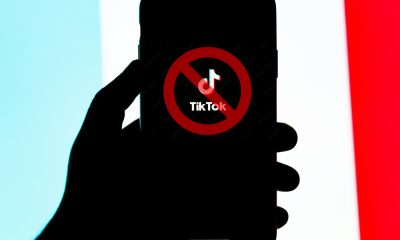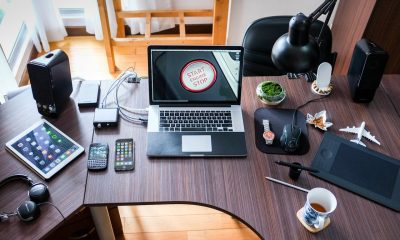How long before you start to show fatigue during a virtual meeting?
Research found that the typical worker switches between four different screens in a workday.
Published
2 months ago on
American workers are officially zoned out just 27 minutes into a meeting, according to new research.
A survey pinpointing the intricacies of modern work life for 2,000 employed Americans, split evenly by generation, found of the 71% who attend virtual meetings, just under 30 minutes of screen-staring is their peak before eye strain strikes and concentration wanes.
From laptops to phones and beyond, the research found that the typical worker switches between four different screens in a workday.
This may be why almost one-third (32%) experience “screen fatigue” at least daily, with 18% reporting they struggle multiple times a day.
The research, conducted by OnePoll on behalf of VSP Vision Care, also found that 40% of respondents feel their eye health has deteriorated over the last year.
“In today’s digital world, it’s more important than ever to get your eyes checked annually – whether you’ve had vision issues or not,” said Dr. Jenn Chinn, a second-generation optometrist at Dr. Chinn’s Vision Care in San Diego, California. “Beyond assessing the best ways to protect and treat your eyes from digital eye strain, annual visits to the eye doctor are critical to assessing your overall eye health and potentially helping to identify other serious health conditions, such as diabetes. However, 31% of survey respondents haven’t had an eye exam in the last two years, which is concerning.”
But it’s not just spreadsheets, emails and meetings our eyes are taking in — the survey also unearthed the more interesting things American workers have seen.
Virtual meetings have revealed pets (41%), other family members (29%) or gave them a glimpse into something new about that person (23%).
On the flip side, unusual items in the background have distracted respondents from the rest of the meeting (22%). Others have struggled to make out exactly what’s behind them (17%) or even noticed something embarrassing or that shouldn’t be seen (16%).
When asked the most intriguing things they’ve seen in virtual meeting backgrounds, respondents outlined scenarios like, “a puppy licked the screen” and even “colleagues who had no time to change and were wearing pajamas for the meeting.”
Results also revealed that more than two-thirds of respondents (69%) admit they’re likely to be “business up top, casual on the bottom” or only sporting professional clothing when visible on camera, with comfy or casual clothes below or off-screen.
However, the younger generations are much more likely to admit to wearing professional tops and casual bottoms (76% of Gen Z and 79% of millennials) than older generations (65% of Gen X and 53% of baby boomers.)
But that upper half seems to make an impression. Two-thirds take those who are dressed professionally more seriously during virtual meetings than those who aren’t – even more so among millennials (74%).
However, only 55% of baby boomers report taking those who are dressed professionally more seriously.
On top of that, employed Americans also believe that those who are wearing obviously professional clothing (32%), have perfectly combed hair (19%) or wear glasses (14%) are more likely to be engaged than those who turn their camera on and off (44%) or are still in their pajamas (34%).

Despite this belief, 15% said they tend to wear their glasses as more of a fashion statement, though 62% wear them out of necessity.
Almost one-quarter (24%) of Gen Z is likely to do so for fashion, more than any other generation. In addition, 35% of respondents said they've worn lenses with a blue light reducing anti-reflective coating.
But even so, 32% agree that they consider people who wear glasses to be smarter than those who don’t, and another 49% agree that glasses make someone appear more professional.
“Whether you wear glasses or not, excessive exposure to screens and the blue light they emit may contribute to digital eye strain. Results of the survey revealed that a significant number of respondents reported they’ve experienced blurry vision (38%), dry eyes (37%) and headaches (32%) after only 30 minutes of screen time – all of which are symptoms of digital eye strain,” said Dr. Valerie Sheety-Pilon, vice president, clinical and medical affairs at VSP Vision™. “Eye health is more than taking frequent breaks while working on digital devices. It’s visiting an eye doctor regularly, practicing good visual hygiene, and wearing the right prescription eyewear that may include blue-light-reducing technology, if recommended by your eye care provider.”
Survey methodology:
This random double-opt-in survey of 2,000 employed Americans split evenly by generation (500 Gen Z, 500 millennials, 500 Gen X and 500 baby boomers) was commissioned by VSP Vision Care between Dec. 6 and Dec. 14, 2023. It was conducted by market research company OnePoll, whose team members are members of the Market Research Society and have corporate membership to the American Association for Public Opinion Research (AAPOR) and the European Society for Opinion and Marketing Research (ESOMAR).
Stories and infographics by ‘Talker Research’ are available to download & ready to use. Stories and videos by ‘Talker News’ are managed by SWNS. To license content for editorial or commercial use and to see the full scope of SWNS content, please email [email protected] or submit an inquiry via our contact form.
You may like
Other Stories


Blood test can detect signs of knee condition 8 years before X-rays
Early detection could lead to treatments that slow the progression of the most common form of arthritis.


Man captures ultra rare albino squirrel on camera
The white squirrel has red eyes so is thought to be an albino squirrel.


Adorable dog kicks his leg while he walks
A video captured the pup bouncing along the street of his native China.


Woman with rare ‘Sleeping Beauty’ condition sleeps every four hours
She was diagnosed at age 18 after years of struggling to stay awake in school and nodding off during class.


97-year-old veteran receives WWII service medal 80 years later
"We’re all so proud of Eve."
Top Talkers

 Parenting1 week ago
Parenting1 week agoSingle mom details struggles of feeding her 12 kids

 Lifestyle1 week ago
Lifestyle1 week agoWoman regrets her tattoo nightmare: ‘It’s horrendous’

 Health5 days ago
Health5 days agoNew study reveals ‘old age’ begins later than it used to

 Wildlife4 days ago
Wildlife4 days agoClever elephant returns visitor’s shoe that fell into enclosure

 Good News4 days ago
Good News4 days agoDisabled student takes first steps in 10 years on graduation stage

 Animals13 hours ago
Animals13 hours agoAdorable dog kicks his leg while he walks

 Entertainment2 days ago
Entertainment2 days agoWhat is the perfect movie length?

 Broadcast19 hours ago
Broadcast19 hours agoAre allergies interfering with your social life?









